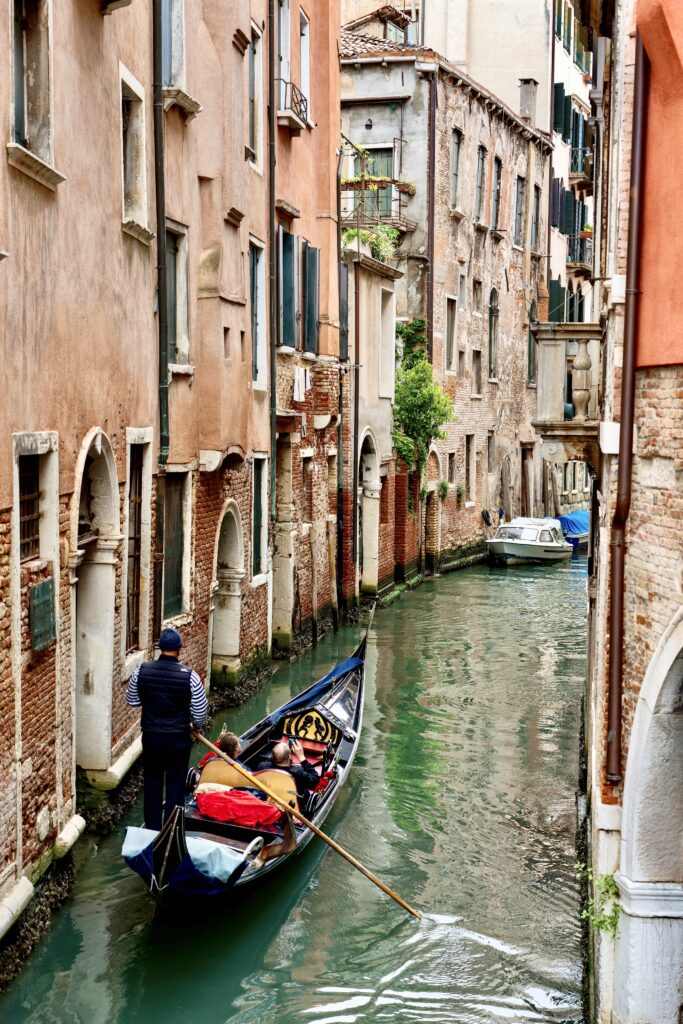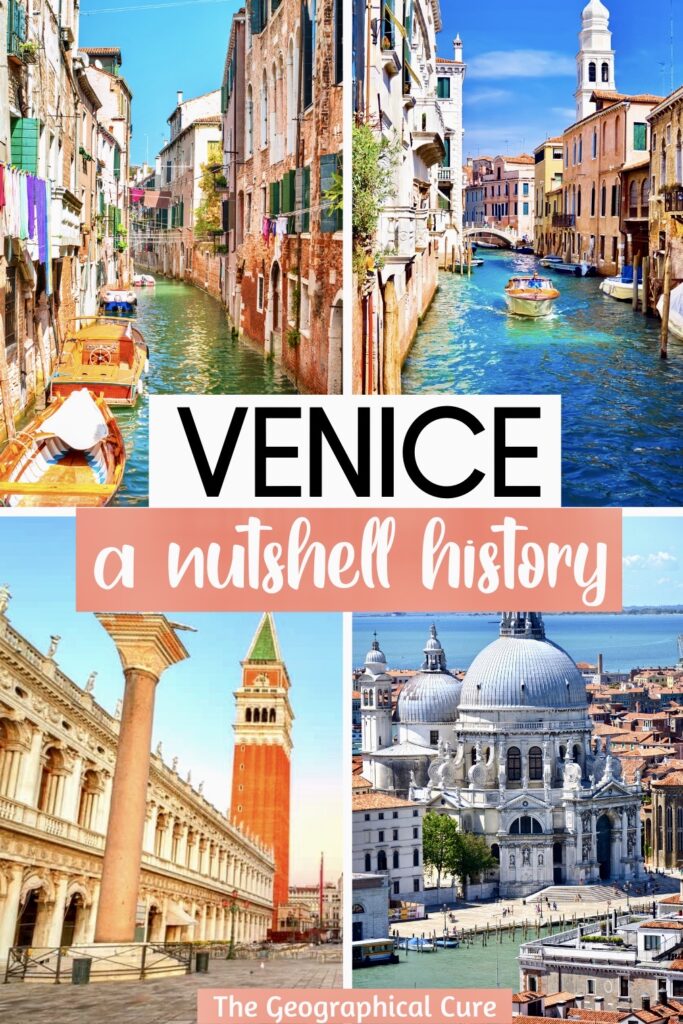“Venice is like eating an entire box of chocolate liqueurs in one go.” — Truman Capote
Here’s my nutshell history of the beautiful floating city of Venice. If you’re thinking of visiting this magical place, you may want to acquaint yourself with its incredible history in advance.
Venice stands as the epitome of uniqueness, unlike any other city in the world. The first glimpse of its glimmering watery streets is an indescribable and almost mystical experience.
Venice defies all rationality. It exists against all odds, a city that seems almost impossible.

Venice is historically a detached island. The history of Venice isn’t tied to the history of Italy.
Venice is unique from the city sates of central Italy such as Rome, Florence, or Siena, and not just because of its blissy canals. Venice sees itself as “La Serenissima,” the most serene and longest lasting republic in Italy.
Let’s take a look at the fascinating history of Venice. It can roughly be divided into three main periods:
- (1) Venice emergence as a seafaring nation on the lagoons;
- (2) Venice’s extraordinary prosperity and the development of a democratic system of government; and
- (3) Venice’s decline in the 16th and 17th centuries, ending with its capture by Napoleon.
History Of Venice In A Nutshell
1. The Founding of Venice
Venice’s traditional founding date is pegged at March 25, 421. The year isn’t arbitrary. It’s 11 years after Rome was sacked by the Visigoths. 421 is also 55 years after the last Roman Emperor was deposed.
Venice chose this particular year as its foundation year because Venice viewed itself as the new Rome. Not as the successor or heir of Rome. But as a new Christian empire.
In the beginning, safety was the key reason people settled on the islands of the Venetian lagoons. People were fleeing from barbarians on the mainland.
To build on the marshy soil, they drove wooden pilons into the ground. Then, they installed stone foundations to build on. It seems almost impossible, but the ingenious transplants found a way.
In 452, a second wave of barbarians, led by Attila the Hun, drove more people into the lagoons. The barbarians weren’t sailors. So it was easy to avoid them this way.
2. Byzantine Domination of Venice
In 526 AD, the Byzantine Emperor Justinian invaded Italy, trying to recapture his lost territories. He landed in Ravenna. Venice fell to the Byzantine empire, which would have a massive influence on their culture.
READ: Guide To The Mosaics Of Ravenna
The relationship between Venice and the Byzantine empire was mutually beneficial financially. Venice offered its loyalty in exchange for exclusive trading routes between the eastern and western worlds. This became the basis for Venice’s maritime power and incredible wealth in later centuries.
The next important date in Venice’s history is 568. That year featured another barbarian invasion, from the Lombards. More refugees headed to the Venetian lagoons. There was still no Venice proper at this point though.
In 726, the Byzantine Emperor Leo III issued a terrible decree. He ordered the destruction of all religious icons and holy images. This decree was known as “Iconoclasm,” which translates to the destruction of images.
3. Venice Steals A Relic To Solidify Power
In the western Christian world, paintings and sculptures played an important role. Encouraged by Pope Gregory II, the imperial provinces of Italy rebelled against the Byzantine decree and fought back. The Byzantine representative in Ravenna was assassinated.
The islands of the lagoon chose their own leader, Paoluccio Anafesto. He became the first dux, pronounced doge. Doges would go on to rule Venice, within a republican framework, for nearly 1000 years. Venice was the only place in Europe not run by kings or the Vatican.
As Venice began to develop socially and politically, the city came to understand its potential importance in the global politics of the time. But Venice needed one last bit of legitimacy to ensure their hegemony.
They needed a relic. All major Christian capitols had an important relic. Venice had a piece of St. Zachariah. But that wasn’t sufficiently important.
To rectify this state of affairs, a popular legend began to spread. One night, because of a violent storm, a ship bearing St. Mark the Evangelist docked near the Rialto Bridge.
An angel came down and said, basically, “peace to you Mark, this will become your final resting place.” The Venetians embraced this legend with zeal.
In fact, this alleged incident became the pretext for the most outrageous grave robbing in Christian history. It was a swashbuckling kidnapping by gondola.
In 829, two Venetians stole St. Mark’s body from Alexandria Egypt and smuggled it back to Venice. They concealed his corpse beneath piles of pork products, so that muslims officials would steer clear.
While at sea, a storm almost drowned the grave robbers and their precious cargo. It was whispered that St. Mark himself appeared to the captain and told him to lower the sails. The ship was saved, and news of a miracle spread.
In 828, the first church of St. Mark was begun. The story of the miracle is even pictured on the 13th century mosaic above the left door as you enter the St. Mark’s Basilica. St. Mark’s symbol was the winged lion, which is a ubiquitous image in Venice.
>>> Click here to book a ticket to St. Mark’s Basilica
With St. Mark as their guardian, Venice evolved into a sea power.
4. The Venetian Constitution
In 878, the Venetians decided to reform and overhaul its political structure.
The doge would no longer be appointed but elected into office, along with two consuls. The idea was to avoid corruption with a system of checks and balances. Venice was now theoretically a democracy.
Shortly thereafter, the Venetian Constitution began to take shape. Judges were instituted in roles as magistrate. The Senate became the most powerful body of government. It consisted of 300 men, 170 of whom regularly attended meetings.
There was also a legislative body, known as the Great Council. All patricians belonged to this group. The last governmental entity was the Court of the Forty.
This was the supreme appeals court for criminal cases. There were various smaller councils as well.
In effect, Venice put together a refined system of government, a blessed mix of liberty and justice.
It was a perfect combination of divine will, monarchy, aristocracy, and democracy. And their system was studied by other republics, including the United States in the 18th century.
This Christian republic would surpass all other Christian republics. Moreover, Venice did this without a definitive historical figure like Pericles, Lorenzo the Magnificent, or Julius Caesar. Venice was a “state as deity” invention.
5. The Great Closing and Rise of the Scuola
In 1297, however, the “great closing” took place and a bit of Venice’s democratic patina was chipped away. The Great Council was drastically reduced. It become filled only with permanent hereditary members.
Venice had disenfranchised 95% of its population.
Venetian society was reorganized into three unequal parts: (1) the patriciate, (2) middle citizens like merchants, and (3) lower classes. This political system remained in place until the 17th century.
This drastic change prompted the rise of the Scuola Grande, or “great schools,” that were effectively fraternities.
The scuola were social organizations composed of different artisan groups and guilds. Because 95% of the population had no political clout, they found other means of power.
The scuola became micro governmental entities. They became important patrons of art and architecture. Almost every famous Venetian painter, sculptor, and architect received commissions from the scuola.
In the 14th century, Venice got into a major scrapes with Genoa and Padua. Political alliances were readily made and betrayed. Venice was often on the defensive. Portugal swiped Venice’s mantle as the chief maritime power.
In the 15th century, Venice had some imperialistic tendencies, repeatedly attempting to extend its territory. But, after being slapped down by a skirmish in 1509, Venice reversed course and adopted a neutral non-expansionist policy.
Venice reveled its isolation and singular identity. Venice began calling itself La Serenissima, the serene one. Wealthy patricians built the gorgeous palaces along the Grand Canal.
6. The Venetian Renaissance
During the Renaissance, in the 15th and 16th centuries, Venice thrived culturally.
Venice had its own version of the Renaissance, distinct from Renaissance hotspots like Rome or Florence. Venice’s artists produced images that were less religious, more libertine, and more creative.
Venetian artists painted female nudes and erotic scenes, without the censure other artists like Michelangelo received. They used looser brushwork, more vibrant colors, and a velvety texture.
READ: Top Art Masterpieces In Venice
Perhaps no work is more emblematic of the Venetian Renaissance than Titian’s Venus of Urbino, which is a star of the Uffizi Gallery in Florence.
>>> Click here to book a ticket to the Uffizi
Venice remained a powerful city state until the 16th century. Then, the decline began. The volume of trade moving through Venice dropped. But Venice still remained a proud center of European culture.
In 1792, Venice opened Europe’s first opera house, La Fenice. (That’s actually where I saw my first opera, Mozart’s Magic Flute, on a college backpacking tour.) Venice abounded with theaters.
The city held an annual carnival. Venetian masks became popular. They were used as a disguise to go to parties, brothels, or gambling establishments.
7. Decline and Pride
But in 1797, Napoleon entered a city that had never before been occupied. The Venetian Republic came to an end. Napoleon absolutely plundered Venice. Some of his trophies were later returned and are now in Venice’s museums.
In 1866, Venice was absorbed into the newly-formed nation of Italy. After WWI, the Lido was developed as an exclusive seaside resort. Venice developed as a major beacon for international tourism. Not surprising for such a spectacular place.
Venice has always had trouble with the Acqua Alta, the high water. In 1966, the city was flooded with more than a meter of salty lagoon water.
But the problems are worsening. The water level is rising and the ground is disappearing, albeit slowly, as the city sinks. The vaporettos may be damaging the buildings as well.
Venetians have taken conservation steps to combat the water. They installed the MOSE, a retractable flood wall, to help protect water pouring into the city.
And yet Venice remains one of Europe’s most captivating cities. It’s a natural movie set. You can’t help but fall in love if the conditions are right.
Just don’t visit in the summer, when cruise ships flood the San Marco area with hordes of tourists. Venice is best enjoyed in the off season or off the beaten path in Dorsoduro and Cannaregio.
I hope you’ve enjoyed my short history of Venice. You may enjoy these other Venice travel guides:
- One day in Venice itinerary
- 2 days in Venice itinerary
- Guide to the Accademia Gallery
- Guide to the Doge’s Palace
- Top Attractions on the Grand Canal
- Guide to the Peggy Guggenheim Collection
- Venice art bucket list
- How many days to spend in Venice?
- 30+ tips for visiting Venice
- Guide to the Frari Church
If you need a history of Venice, pin it for later.

